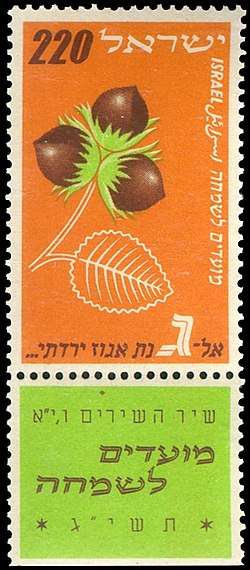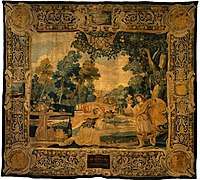Song of Songs 6
Song of Songs 6 (abbreviated as Song 6) is the sixth chapter of the Song of Songs in the Hebrew Bible or the Old Testament of the Christian Bible.[1][2] This book is one of the Five Megillot, a collection of short books, together with Book of Ruth, Lamentations, Ecclesiastes and Esther, within the Ketuvim, the third and the last part of the Hebrew Bible.[3] Jewish tradition views Solomon as the author of this book, and this attribution influences the acceptance of this book as a canonical text, although this is at present largely disputed.[3] This chapter contains a dialogue between the daughters of Jerusalem and the woman about the man, followed by the man's descriptive poem of the woman, ending with a collective call to the woman to return.[4]
| Song of Songs 6 | |
|---|---|
 Inscription "I went down into the garden of nuts" and on tab: "Song of Solomon 6:11", "Joyous Festivals 5713" stamp - 220 mil. | |
| Book | Song of Songs |
| Category | Ketuvim |
| Christian Bible part | Old Testament |
| Order in the Christian part | 22 |
Text
The original text is written in Hebrew language. This chapter is divided into 13 verses.
Textual witnesses
Some early manuscripts containing the text of this chapter in Hebrew are of the Masoretic Text, which includes the Codex Leningradensis (1008).[5][lower-alpha 1] Some fragments containing parts of this chapter were found among the Dead Sea Scrolls: 4Q106 (4QCanta; 30 BCE-30 CE; extant verses 11(?)-12).[7][8][9]
There is also a translation into Koine Greek known as the Septuagint, made in the last few centuries BCE. Extant ancient manuscripts of the Septuagint version include Codex Vaticanus (B; B; 4th century), Codex Sinaiticus (S; BHK: S; 4th century), and Codex Alexandrinus (A; A; 5th century).[10]
Structure
Modern English Version (MEV) groups this chapter into:
- Song 6:1 = Friends of the Woman
- Song 6:2-3 = The Woman
- Song 6:4-12 = The Man
- Song 6:13a = Friends of the Woman
- Song 6:13b = The Man
Chorus: Inquiry for the male (6:1)
Continuing from chapter 5 the daughters of Jerusalem agree to look for the man.[4]
Female: Reunites with her lover (6:2-3)
This part contains the woman's affirmation of her love, when she finds him enjoying his garden.[4]
Verse 2
- My beloved is gone down into his garden, to the beds of spices, to feed in the gardens, and to gather lilies.[13]
This could be related to Ecclesiastes 2:5, 6 where Solomon says, "I planted me vineyards; I made me gardens and parks, and I planted trees in them of all kinds of fruit; I made me pools of water, to water therefrom the forest where trees were reared."[14]
Male: Second descriptive poem for the female (6:4-10)
This descriptive poem by the man still belongs to a long section concerning the desire and love in the country which continues until 8:4,[17] and partly parallel to the one in chapter 4.[4] The man's waṣf and the other ones (4:1-8; 5:10-16; 7:1-9) theologically demonstrate the heart of the Song that values the body as not evil but good even worthy of praise, and respects the body with an appreciative focus (rather than lurid).[18] Hess notes that this reflects 'the fundamental value of God's creation as good and the human body as a key part of that creation, whether at the beginning (Genesis 1:26-28) or redeemed in the resurrection (1 Corinthians 15:42, 44)'.[18]
Verse 4
- You are beautiful as Tirzah, my love,
- comely as Jerusalem,
- awesome as an army with banners![19]
- Tirzah: the capital of the Kingdom of Northern Israel in the late 10th and early 9th BCE; likely identified with Tell el-Farah North.[20]
- "My love" (or "my [female] friend"; Hebrew: רעיתי, ra‘-yā-ṯî[21]) a specific term of endearment used by the man for the woman that is used 9 times in the book (Song 1:9,15; 2:2,10,13; 4:1,7; 5:2; 6:4).[22][23] The masculine form of the same root word to call the man ("my [male] friend"; Hebrew: רעי, rê-‘î[24])[lower-alpha 2] is used in a parallel construction with "my beloved" (Hebrew: דודי, ḏōḏî[24]) in Song 5:16.[22]
Female: Lingering in the groves (6:11-12)
The woman's voice in this part contains ambiguity in the meaning of some words, that poses difficulty in assigning it to either of the main speakers (NIV assigns this part to the man).[26]
Verse 11

- I went down into the garden of nuts to see the fruits of the valley, and to see whether the vine flourished and the pomegranates budded.[27]
- "Nuts" (Hebrew: אֱגוֹז, ’ĕ-ḡōz[28]): only found here in Hebrew Bible, but more in the Talmud; may specifically refer to the walnut tree (Juglans regia).[26]
Verse 12
- Or ever I was aware, my soul made me like the chariots of Amminadib.[29]
- "Amminadib": or "my noble people".[30] The Septuagint and Vulgate, as in the King James Bible refer this last part of the verse to an individual named Amminadib (or variant spelling "Aminadab").[31] K. Froehlich notes that "Amminadab's chariot" was interpreted as a four-horse chariot or quadriga during the Middle Ages, and considered 'a cipher for the fourfold meaning and interpretation of Scripture'.[32]
Chorus: Call to return (6:13)
This verse does not indicate clearly who the speaker is, but there must be either multiple persons concerned in it or a quotation, because 'there is an evident interchange of question and answer'.[12]
Verse 13
[Friends of the Woman]
- Return, return, O Shulammite!
- Return, return, that we may look upon you.
[The Man]
- Why should you look upon the Shulammite,
- as upon a dance before two armies?[33]
- "Shulammite": The name for the bride which only occurs here in the whole book, but 'it cannot be a proper name, otherwise even in the vocative there would be no article, as there is here', so it can be interpreted as 'maiden of Shulam' (cf. the Shunammite, 1 Kings 1:3).[12] It could be how the courtiers call her, not knowing her true name, so they use 'the name of the village near which they were when they saw her'.[12]
- "A dance before two armies" (KJV: "the company of two armies"): or "dance of Mahanaim".[34]
Notes
- Since 1947 the current text of Aleppo Codex is missing Song of Songs 3:11, after the word ציון ("Zion"), to the end.[6]
- Another use of rê·‘î in the Hebrew Bible is in Job 31:9.[25]
References
- Halley 1965, p. 279.
- Holman Illustrated Bible Handbook. Holman Bible Publishers, Nashville, Tennessee. 2012.
- Brenner 2007, p. 429.
- Brenner 2007, p. 431.
- Würthwein 1995, pp. 36-37.
- P. W. Skehan (2003), "BIBLE (TEXTS)", New Catholic Encyclopedia, 2 (2nd ed.), Gale, pp. 355–362
- Ulrich, Eugene, ed. (2010). The Biblical Qumran Scrolls: Transcriptions and Textual Variants. Brill. pp. 744. ISBN 9789004181830. Retrieved May 15, 2017.CS1 maint: ref=harv (link)
- Dead sea scrolls - Song of Songs.
- Fitzmyer, Joseph A. (2008). A Guide to the Dead Sea Scrolls and Related Literature. Grand Rapids, MI: William B. Eerdmans Publishing Company. p. 42. ISBN 9780802862419. Retrieved February 15, 2019.CS1 maint: ref=harv (link)
- Würthwein 1995, pp. 73-74.
- Song 6:1 MEV
- Cambridge Bible for Schools and Colleges. Song of Solomon 6. Accessed April 28, 2019.
- Song 6:2 KJV
- Exell, Joseph S.; Spence-Jones, Henry Donald Maurice (Editors). On "Song of Solomon 6". In: The Pulpit Commentary. 23 volumes. First publication: 1890. Accessed April 24, 2019.
- Song 6:3 KJV
- Jamieson, Robert; Fausset, Andrew Robert; Brown, David. Jamieson, Fausset, and Brown's Commentary On the Whole Bible. "Song of Solomon 6". 1871.
- Hess 2005, p. 36.
- Hess 2005, p. 127.
- Song 6:4 MEV
- Coogan 2007, p. 965 Hebrew Bible.
- Hebrew Text Analysis: Song of Solomon 6:4. Biblehub
- Bergant 2001, p. 19.
- Strong's Concordance: 7474. rayah. Biblehub
- Hebrew Text Analysis: Song of Solomon 5:16. Biblehub
- Englishman's Concordance: rê·‘î — 2 Occurrences. Biblehub
- Longman 2001, p. 184.
- Song 6:11 KJV
- Hebrew Text Analysis: Song of Solomon 6:11. Biblehub
- Song 6:12 KJV
- Note on Song of Solomon 6:12 in NKJV
- Longman 2001, p. 185.
- Froehlich, K. "Amminadab's Chariot: The Predicament of Biblical Interpretation," Princeton Seminary Bulletin 18 (1997): 262-78, apud Longman 2001, p. 185
- Song 6:13 MEV or Song 7:1 in Hebrew Bible (Note [a] on Song of Solomon 6:13 in MEV)
- Note [b] on Song of Solomon 6:13 in MEV
Sources
- Bergant, Dianne (2001). Cotter, David W.; Walsh, Jerome T.; Franke, Chris (eds.). The Songs of Songs. Berit Olam (The Everlasting Covenant): Studies In Hebrew Narrative And Poetry. Liturgical Press. ISBN 9780814650691.CS1 maint: ref=harv (link)
- Brenner, Athalya (2007). "21. The Song of Solomon". In Barton, John; Muddiman, John (eds.). The Oxford Bible Commentary (first (paperback) ed.). Oxford University Press. pp. 429–433. ISBN 978-0199277186. Retrieved February 6, 2019.CS1 maint: ref=harv (link)
- Coogan, Michael David (2007). Coogan, Michael David; Brettler, Marc Zvi; Newsom, Carol Ann; Perkins, Pheme (eds.). The New Oxford Annotated Bible with the Apocryphal/Deuterocanonical Books: New Revised Standard Version, Issue 48 (Augmented 3rd ed.). Oxford University Press. ISBN 9780195288810.CS1 maint: ref=harv (link)
- Exum, J. Cheryl (2005). Songs of Songs: A Commentary. Old Testament library (reprint ed.). Westminster John Knox Press. ISBN 9780664221904.CS1 maint: ref=harv (link)
- Halley, Henry H. (1965). Halley's Bible Handbook: an abbreviated Bible commentary (24th (revised) ed.). Zondervan Publishing House. ISBN 0-310-25720-4.CS1 maint: ref=harv (link)
- Hess, Richard S. (2005). Songs of Songs. Baker Commentary on the Old Testament Series. Baker Academic. ISBN 9780801027123.CS1 maint: ref=harv (link)
- Longman, Tremper (2001). Songs of Songs. The New International Commentary on the Old Testament. Volume 26. Wm. B. Eerdmans Publishing. ISBN 9780802825438.CS1 maint: ref=harv (link)
- Würthwein, Ernst (1995). The Text of the Old Testament. Translated by Rhodes, Erroll F. Grand Rapids, MI: Wm. B. Eerdmans. ISBN 0-8028-0788-7. Retrieved January 26, 2019.CS1 maint: ref=harv (link)
External links
- Jewish translations:
- Shir Hashirim - Song of Songs - Chapter 6 (Judaica Press) translation [with Rashi's commentary] at Chabad.org
- Christian translations:
- Online Bible at GospelHall.org (ESV, KJV, Darby, American Standard Version, Bible in Basic English)
- Song of Solomon Chapter 6 King James Version
